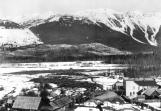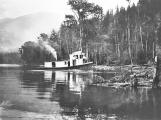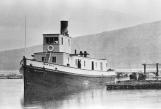1
Through the years 1903 and 1904, the intensity of commercial growth especially in the marine and forestry divisions was staggering. Shipbuilding of another kind emerged! Sternwheeler production was being replaced by the construction of boats using propellers - namely tugs. The Yale Columbia Lumber Co. replaced the decadent Henrietta and Fawn by new vessels called the Yale, Irene and Smuggler. At Comaplix the company produced the Geo. F. Piper; while at Arrowhead there was the Adam Hall.
While production of tugs was a boon to ship building in Nakusp, it was the expansion of sawmills that was the root of such action and employment. When the DeCew mill was bought and moved to Arrowhead, it immediately doubled the work force in that town. In turn, Ralph Simpson now started a shingle mill close to the site of the old DeCew plant.
2
William McKissock had moved to Vancouver from Owen Sound. After establishing a successful shipbuilding business there with partner, Wallace, he was told he had to move to the interior or die from a severe asthma condition. This was an important gain for the Arrow Lakes because his expertise was just what was needed. His first job was to build the SS Yale for the Yale Columbia Lumber Co. in Nakusp in 1903. Fred was on hand to watch the gradual formation of the large tug.
3
Yale Tug
Arrowhead, BC

4
It was probably due to Jack Genelle's daughter, Irene, that this name was given to the second Yale Columbia Lumber Co. tug built by McKissock. Very similar in style as the Yale tug, the main deck had a high wheelhouse which was designed that way to give good vision in all directions. It was the massive timber rights owned by the YCL Co. in the upper region of the Arrow Lakes that kept these tugs towing constantly to the mill in Nakusp.
5
Beaton with decked logs.
circa 1904
Beaton, BC

6
Still without its wheelhouse, the Irene was prematurely launched after only six weeks on the ways in order to start the building of a much smaller tug - the Smuggler. Steam was produced quickly in the boiler of the Smuggler by the use of tubes installed directly in the fire box. It was a system requiring that the fire be started with care. It was a little work horse that would outlast them all.
7
Smuggler
Early 1900's
Arrow Lakes, BC

8
At Comaplix, the former Harbour Lumber Co., now renamed the Empire Lumber Co., made plans to spend over $200,000.00 on upgrading the mill there in 1904. To manage all the marine work, they again engaged William McKissock to construct a tug at Nakusp shipyard. To be called the Geo. F. Piper, it was a handsome boat equipped for both towing and carrying passengers from Comaplix to Arrowhead; a run it could make in just 30 minutes. Captain Rhoda, who was in charge of the vessel, was happy that its boiler could be fired using coal or wood.
9
Geo. F. Piper
circa 1904
Northeast Arm, Arrow Lakes

10
The grand-daddy of all the early tugs was built and launched at Arrowhead in 1904 by the Big Bend Lumber Co. Looking more like a small sternwheeler the twin engine, twin screw behemoth could hold 24 cords of wood. The tug had such power it seldom labored causing the steam pressure valve to blow quite often. Considering most of her tows were short in duration the boat was a bit of overkill.
11
Adam Hall Tug
1904
Arrowhead, BC





